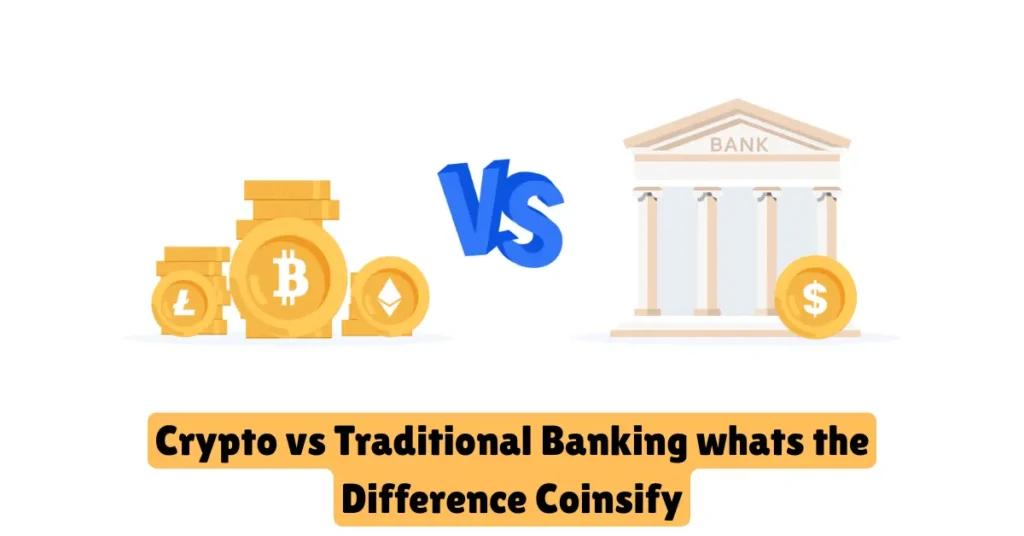Crypto vs Traditional Banking whats the Difference?
Introduction
In today is digital world, the way we manage money is evolving rapidly. On one side, we have traditional banking – a system we’ve relied on for generations. On the other hand, we have cryptocurrency – a new-age financial technology that’s changing how people think about money, security, and control.
With the rise of crypto, many are asking: How is it different from regular banking? Is one better than the others? Or can they work together?
In this article, we will break down the key differences between cryptocurrency and traditional banking.
Let’s do it.
Key Differences Between Crypto and Traditional Banking
To understand how cryptocurrency and traditional banking differ, it is important to look at how each system operates. Below is a simple breakdown of their core differences:
| Aspect | Traditional Banking | Cryptocurrency |
| Control & Authority | Controlled by banks and central governments | Decentralized; no single entity controls the network |
| Regulation | Heavily regulated with legal oversight | Lightly regulated or unregulated in many regions |
| Transaction Speed | Transactions may take hours or days | Most transactions are completed in minutes |
| Fees | Includes various fees (ATM, wire transfer, account fees) | Generally lower fees, especially for international transfers |
| Access Requirements | Requires identification, verification, and bank accounts | Accessible to anyone with internet and a digital wallet |
| Availability | Limited to business hours and holidays | Operates 24/7 without interruption |
| Security | Protected by national laws, banks, and insurance systems | Secured through blockchain technology and cryptographic keys |
| Privacy | Banks may track and share financial activity | Offers more privacy, though transactions are publicly visible |
| Currency Type | Uses fiat currencies like USD, EUR, INR | Uses digital coins or tokens like Bitcoin, Ethereum, etc. |
| Physical Infrastructure | Includes various fees (ATM, wire transfer, and account fees) | Requires branches, ATMs, and staff |
This comparison shows that both systems have their strengths and weaknesses. While traditional banking is more established and regulated, cryptocurrency offers speed, innovation, and global access without the need for intermediaries.
Pros and Cons of Traditional Banking
Traditional banking has been the foundation of the global financial system for decades. While it offers many benefits, it also comes with its limitations. Here’s a closer look:
Pros of Traditional Banking
| Trust and Regulation Banks are regulated by government authorities, which means your money is protected by laws and financial policies. |
| Deposit Insurance In most countries, deposits are insured up to a certain limit (like $250,000 in the U.S.), which adds a layer of financial security. |
| Wide Acceptance Bank accounts and debit/credit cards are accepted almost everywhere, making transactions convenient. |
| Customer Support Banks offer dedicated customer service, both in-branch and online, to assist with your financial needs. |
| Loan and Credit Services Traditional banks provide structured lending services such as home loans, personal loans, and credit cards with credit scoring systems. |
Cons of Traditional Banking
| High Fees Banks often charge fees for account maintenance, ATM withdrawals, international transfers, and more. |
| Limited Access Accessing your bank account may be restricted during non-business hours or holidays. |
| Slow Transactions International transfers and interbank transactions can take days to process. |
| Lack of Privacy Banks track your transactions and may share data with authorities or third parties as required by law. |
| Exclusion of Unbanked Populations Millions of people worldwide still lack access to banking due to strict verification requirements or a lack of infrastructure. |
This section highlights that while traditional banks offer stability and security, they also face challenges in speed, cost, and accessibility, especially when compared to modern alternatives like cryptocurrency.
Pros and Cons of Cryptocurrency
Cryptocurrency is a modern digital alternative to traditional money. While it offers exciting advantages, it’s not without its risks. Let’s explore the pros and cons of using crypto.
Pros of Cryptocurrency
| Decentralization Cryptocurrencies are not controlled by any single authority or government, giving users more freedom and independence. |
| Fast and Low-Cost Transactions Especially for international payments, crypto transactions are often quicker and cheaper than traditional bank transfers. |
| Global Accessibility Anyone with internet access can use cryptocurrencies, even those without access to traditional banking. |
| Privacy and Security Crypto transactions are secured through cryptography and blockchain, offering a high level of security and a certain degree of anonymity. |
| 24/7 Availability Crypto networks operate continuously without downtime, there are no banking hours or holidays. |
| Investment Potential Many people invest in cryptocurrencies, hoping for high returns, as prices can rise significantly over time. |
Cons of Cryptocurrency
| Price Volatility Crypto prices can change rapidly. This high volatility makes it risky for savings or everyday use. |
| Lack of Regulation Without consistent global regulation, there’s a higher risk of fraud, scams, or market manipulation. |
| Limited Acceptance While adoption is growing, most businesses and governments still don’t accept cryptocurrency as a standard form of payment. |
| Security Risks If you lose access to your digital wallet or private keys, there’s no way to recover your crypto funds. |
| Technical Complexity Understanding how crypto works, wallets, keys, and blockchain can be overwhelming for beginners. |
This section shows that cryptocurrency offers innovation, speed, and freedom, but it also requires users to be cautious, informed, and responsible. It’s a powerful tool, especially when used wisely.
Which One is Better?
There’s no clear winner, it depends on what you need.
If you’re looking for stability, legal protection, and trusted services, traditional banking is a better fit. It’s ideal for saving money, getting loans, and handling day-to-day transactions.
But if you value speed, privacy, lower fees, and full control of your money, cryptocurrency can be a great option, especially for online payments or international transfers.
Many people are now using both systems together. For example, they use banks for regular savings and crypto for investing or sending money across borders.
In short, neither is “better” for everyone; the right choice depends on your goals, location, and comfort with technology.
Frequently Asked Questions (FAQs)
What is the main difference between cryptocurrency and traditional banking?
Traditional banking is controlled by banks and governments, while cryptocurrency is a digital, decentralized system that doesn’t rely on any central authority.
Is cryptocurrency safe to use?
Yes, if used correctly. Crypto is secured by blockchain technology, but it’s important to store it safely in a trusted wallet and be careful of scams.
Can I use crypto like normal money?
In some places, yes. You can use crypto to buy products and services online, but it’s still not accepted everywhere like cash or credit cards.
Do I need a bank account to use cryptocurrency?
No. One of the main benefits of crypto is that you don’t need a bank account — just a digital wallet and internet access.
Is crypto legal?
It depends on where you live. Many countries allow crypto, but some have restrictions. Always check your local laws before using it.
Can I lose money with cryptocurrency?
Yes. Crypto prices can go up or down quickly. It’s important to invest carefully and only with money you can afford to lose.
How are crypto transactions different from bank transfers?
Crypto transactions are usually faster and have lower fees, especially for international transfers. They also don’t need approval from banks.
Can crypto replace banks in the future?
Maybe not completely, but crypto could change how banks work. Some experts believe both systems can work together in the future.
What is blockchain in simple terms?
Blockchain is like a digital notebook that records every transaction across a network. It’s open, secure, and can’t be changed once recorded.
Do I pay tax on cryptocurrency?
In many countries, yes. If you make money from crypto (like profits from trading), it may be taxed. It’s best to check with a tax advisor.
Conclusion
Both cryptocurrency and traditional banking have their own strengths and weaknesses. Traditional banks offer safety, regulation, and wide acceptance, while crypto gives you more control, faster transactions, and global access.
The best choice depends on your needs. You don’t have to pick one over the other, many people use both. Understanding how each works helps you make smarter financial decisions in today’s changing world.
Also read
- What is a Crypto Wallet and How Does It Work? – Coinsify
- 10 Crypto Terms Every Beginner Must Know – Coinsify
- What is Blockchain Technology – Complete Guide – Coinsify
- How to Buy Crypto Safely in 2025 – Complete Guide – Coinsify
- Bitcoin vs Ethereum: Key Differences Explained – Complete Guide
- Ultimate Blockchain Glossary: Learn Blockchain Terms Easily
- How to Buy Bitcoin Safely (Complete Beginner’s Guide)
- Top 10 Crypto Wallets for Beginners (2025 Edition)
- What is Cryptocurrency? A Beginner-Friendly Guide (2025)






